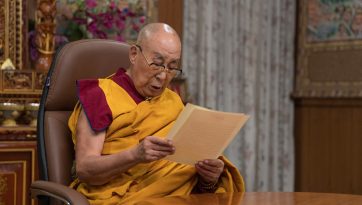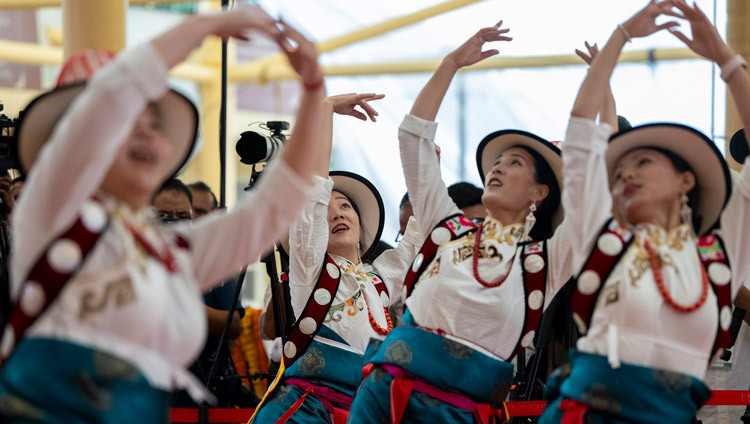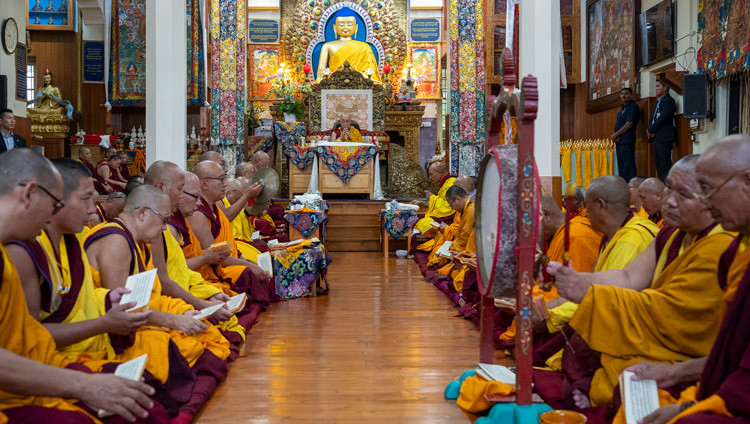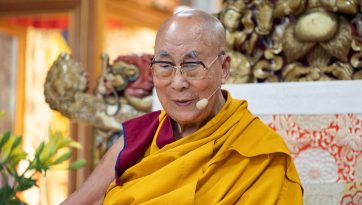www.tibet.net, August 20, 2013
On the occasion of the second anniversary of the 14th Kashag, Sikyong Dr Lobsang Sangay gave the following exclusive interview to Tibet.net.
1. How would you describe your administration’s overall strategic approach as you complete two years in office?
2. What is the Middle Way Policy and how has this policy benefited Tibet and Tibetans?
3. What is the cause of the unprecedented wave of self-immolations in Tibet and how has your Administration handled this painful issue?
4. Would you like to make any clarifications on the May 8, 2013 AFP article Exiled Tibetan PM not challenging Chinese Communist Party’s rule in Tibet?
5. What is CTA’s stand on Tibetans applying for Indian or other foreign citizenship?
6. What is the state of CTA’s finances?
7. How is the CTA helping new arrivals from Tibet and tackling youth unemployment in the Tibetan exile community?
8. What are some of your new initiatives in education and what is the current status of the transfer of CTSA-run schools to the CTA?
9. What are your thoughts on the state of gender equality in the exile Tibetan community and what measures has your Administration taken in this area?
10. Lastly, what is the current status of the Canada Tibetan re-settlement program and could you please provide an update on the U.S. Immigration Bill that has a provision for 5000 visas for Tibetans?
1. How would you describe your administration’s overall strategic approach as you complete two years in office?
The 14th Kashag had the formidable challenge of ensuring a smooth transition in the wake of His Holiness the Dalai Lama’s historic decision to devolve his political authority to a democratically elected leader while sustaining the Tibetan freedom struggle. The strategic approach we have taken at a macro level can be summarized as a three-phase integrated approach of consolidation, action and dialogue.
The consolidation phase that spanned much of the first year was focused on ensuring a smooth transition. Our priority during this time of transition was to avoid disruption; and rally all Tibetans and supporters. Towards this end, we hosted several major conferences in Dharamshala that brought together Tibetan representatives from all across the globe and leaders of the Indian and International Tibet Support Groups.
With His Holiness’ blessing, Tibetans inside and around the world have fully supported the transition and taken responsibility in fulfiling the vision of His Holiness the Dalai Lama. The 14th Kashag would like to express its appreciation for the support and urge Tibetans to continue to do so. This support has been instrumental during the consolidation phase.
The action phase witnessed major solidarity events in several cities including New York, New Delhi, Brussels, Tokyo, Sydney and others. These solidarity events were complemented by media awareness and efforts to garner support for Tibet in congresses and parliaments across the world. Working with friends and supporters of Tibet, we were able to get declarations, resolutions and motions passed in parliaments in the European Union, Australia, Brazil, Japan, France, Italy, Luxembourg, the United States and other countries.
The dialogue phase involves sustained efforts and initiatives to resume contact with the Chinese government. Additional investment will be made to educate both Tibetans and external audiences on the Middle Way Approach. The Task Force on Negotiations will be enlarged and members will have their 26th meeting in September 2013 during which ongoing developments in Tibet and China will be reviewed and discussed.
2. What is the Middle Way Policy and how has this policy benefited Tibet and Tibetans?
As early as the 1970s, His Holiness the Dalai Lama began to formulate a far-sighted and pragmatic solution to the Tibet issue after consulting various Tibetan leaders in exile and later in the 1980s also soliciting feedback from Tibetans inside Tibet.
The new formulation traversed the middle path between repression and separation – rejecting the repressive and colonial policies of the Chinese government towards Tibetans while not seeking separation from the People’s Republic of China. This win-win proposition, which came to be known as the Middle Way Approach, calls for genuine autonomy for the Tibetan people within the framework of the People’s Republic of China. This approach was also in sync with then China’s paramount leader Deng Xiaoping’s position that, “except for independence, all other issues could be discussed and resolved.”
The Middle Way Approach has enabled Dharamshala and Beijing to establish contact through a series of talks held between Chinese representatives and envoys of His Holiness the Dalai Lama. For the first time, Tibetans inside and outside Tibet were able to contact and visit one another. Tibetan students and monks in Tibet visited India to receive secular and monastic education, which also contributed to the revival of Buddhism inside Tibet and awareness and solidarity with the exile Tibetans.
Many prominent educated Tibetans inside Tibet support the Middle Way Approach because they view it as a realistic and forward-looking approach to peacefully resolving the issue of Tibet. Furthermore, this approach enables many governments to support a solution-oriented Tibet policy and helps them raise the Tibet issue in their bilateral dialogue with China. After President Barack Obama’s meeting with His Holiness the Dalai Lama on July 16, 2011, the White House applauded “the Dalai Lama’s commitment to non-violence and dialogue with China and his pursuit of the Middle Way Approach,” and encouraged “direct dialogue to resolve long-standing differences.”
Another key area where the Middle Way Approach is steadily bearing results is in the minds of many Chinese, particularly among the intellectuals. Some of the Chinese intellectual luminaries, including Liu Xiaobo, the imprisoned Nobel Laureate, were signatories of a courageous open letter in 2008 that expressed support for His Holiness the Dalai Lama’s peace initiatives. His Holiness the Dalai Lama’s outreach to Chinese students and scholars and his teachings to Chinese Buddhist practitioners, part of an estimated 300 million plus Buddhists in today’s Mainland China, are also helping reshape Chinese attitudes towards Tibet and Tibetans.
For all the reasons stated above, the Central Tibetan Administration (CTA) remains committed to the Middle Way Approach in resolving the Tibet issue.
3. What is the cause of the unprecedented wave of self-immolations in Tibet and how has your Administration handled this painful issue?
On the second anniversary of the present Kashag, a special prayer session was held in dedication to 120 self-immolators, their family members and for all those who have given their lives for the cause of Tibet. Similar prayer sessions were held in the Tibetan settlements in India and abroad.
Sadly, since 2009, 120 Tibetans have self-immolated, including 22 in 2013. 103 of them have died. The self-immolators include monks, nuns, nomads, farmers, students and Tibetans from all three Tibetan regions of U-Tsang, Kham and Amdo, including the capital city of Lhasa.
Political repression, cultural assimilation, social discrimination, economic marginalisation, environmental destruction and lack of religious freedom are the primary factors driving Tibetans to self-immolation. According to Human Rights Watch, two million nomads were resettled in ghetto-like accomodations without their full consent and proper consultation. The repressive policies has also resulted in recent incidents of violence in several mining areas in Tibet. The only way to end this brutal and grave situation is for China to change its current hardline Tibet policy by respecting the aspirations of the Tibetan people. We are always mindful of the fact that our compatriots inside Tibet hold the key to the Tibet issue.
The Kashag has consistently appealed to and discouraged Tibetans from drastic action, including self-immolation, as a form of protest. As human beings, we do not want anyone to die in such a manner. However, as Buddhists, we pray for the deceased. As Tibetans, it is our sacred duty to support the aspirations of Tibetans in Tibet: the return of His Holiness the great Fourteenth Dalai Lama to Tibet, freedom for the Tibetan people, and unity among Tibetans.
The blame as well as the solution for the self-immolations lies with the Chinese government.
4. Would you like to make any clarifications on the May 8, 2013 AFP article Exiled Tibetan PM not challenging Chinese Communist Party’s rule in Tibet?
Those who have heard or read my remarks at the Council on Foreign Relations (CFR) in Washington DC, the basis of the AFP article, should have no grounds to be alarmed. There is no divergence between my comments and the long-held official CTA position on major issues such as the role of the Communist Party in Tibet, democracy in Tibet, and control of Tibet’s defense. These official CTA positions were articulated in the Memorandum on Genuine Autonomy For the Tibetan People and the accompanying Note on the Memorandum of Genuine Autonomy for the Tibetan People (hereinafter referred to as Note), submitted to the Chinese government in 2008 and 2010 respectively.
As far as Socialism and the role of China’s Communist Party in a Tibet that is genuinely autonomous is concerned, I urge readers to review chapters 3, 4 & 5 of the Note, which clearly states, “The Memorandum, in no way challenges or brings into question the leadership of the Chinese Communist Party in the PRC. The Memorandum also does not challenge the Socialist system of the PRC. Nothing in it suggests a demand for a change to this system or for its exclusion from Tibetan areas.”
With reference to democracy, I was asked by the CFR event moderator “Do you think you can institute democracy in a genuinely autonomous Tibet? Will there be real, free political elections, freedom of expression? It would be unique to the People’s Republic, wouldn’t it?” The answer to these questions is “no.” As I explained at the CFR event, “democracy is what we practice and this is what we aspire. But this is not part of what we are asking.” As explained we do not challenge or demand a change to the socialist system of the PRC and leadership of the Communist Party if we are granted genuine autonomy.
5. What is CTA’s stand on Tibetans applying for Indian or other foreign citizenship?
The decision to apply for Indian or any other country’s citizenship is a personal choice. The Indian Citizenship Act of 1986 grants citizenship rights to Tibetans born in India between 1950 and 1987; and to those born after 1987 if “either of whose parents is a citizen of India at the time of his/her birth”. CTA cannot prevent any Tibetan from applying for Indian citizenship. At the same time, CTA cannot compel Tibetans to apply for Indian citizenship, as the application process entails surrendering both Registration Certificate (RC) and Identity Certificate (IC) documents to the Indian authorities.
Also, the primary objective of CTA is political and to provide welfare services to Tibetans in exile.
CTA issues bona fide Tibetan letters of support through our Offices of Tibet to those applying for citizenships abroad. We also issue “No Objection Certificate” (NoC) through our Department of Security to applicants for Indian citizenship. During my administration, we have so far, received exactly 14 requests for NoC and we have not withheld supporting documents for anyone.
6. What is the state of CTA’s finances?
CTA is financially sound. During the Tibetan Parliament-in-Exile’s budget session in March 2013 the 14th Kashag submitted a budget for the fiscal year 2013-2014 that includes new revenue representing an increase of 23% over the previous budget. We are confident we will not only raise, but also exceed our revenue goal.
The current 2013-2014 budget includes 97 new projects, including programs for settlement revitalization and youth employment, which will positively impact a majority in the Tibetan refugee community. The budget also includes an increase in monthly stipend for former political prisoners from INR 3500 to 6000, for elderly people without family from INR 900 to 1500, and for people with special needs from INR 700 to 1500. Health and education for those living below the poverty line are also covered. It includes performance-based scholarships for higher studies to encourage academic excellence. The budget also strengthens CTA’s IT infrastructure and upgrades all computer hardware and software.
The voluntary cha-ngul payment by individual Tibetans, which constitutes about 8% of annual CTA’s revenue. I commend those Tibetans who are regular contributors, and encourage others to begin to make such voluntary contributions. The amount is modest, but important symbolically as it reflects a personal commitment to the Tibetan cause and support for CTA as an institution.
Lastly, let me say that CTA funds are prudently managed with clear controls in place. Approval is needed from either the Tibetan Parliament-in-Exile or its Standing Committee before the Kashag can receive or spend funds. Top
7. How is the CTA helping new arrivals from Tibet and tackling youth unemployment in the Tibetan exile community?
I am happy to report that we have allocated an additional sum of INR155 lakhs (USD293,000) from the current CTA budget for the rehabilitation of new arrivals from Tibet in Dharamshala and other places.
The curriculum at the Sherab Gatsel Lobling School (SGLS), formerly known as Tibetan Transit School, has been thoughtfully upgraded and redesigned. This new program expands the school’s focus from basic education to basic education plus skills and vocational training. Furthermore, SGLS students who qualify, will now have the option to pursue college and university education.
Beginning this budget year, we have launched a new program to offer a second chance for those new arrivals who are 35 years and older, and for those who have dropped out of SGLS and are unemployed, to reapply for a two-year program.
The Department of Security provides new arrivals with much-needed assistance in obtaining all their necessary documents. The Department of Health offers medical care and attention to torture survivors among the new arrivals and also provides them life-skill training. The Department of Religion & Culture gives monthly stipends to the new arrival monks and nuns and facilitates admission into their choice of monasteries and nunneries in India.
Although there is a decrease in the number of new arrivals from Tibet into India, the Tibetan Reception Centres in Kathmandu, New Delhi and Dharamshala continue to facilitate their safe journey and looks after their essential needs until the time they are enrolled in secular or monastic educational institutions.
On a related note, we are also committed to tackling the problem of youth unemployment. We all know that the success of any community rests on the productivity of its youth, and that today’s Tibetan youth are tomorrow’s future. With this in mind, we have launched several initiatives in this arena:
· A pilot Business Process Outsourcing (BPO) venture was launched in Dharamshala, as a joint effort of CTA’s Tibetan Administration and Welfare Society (TAWS) and OKS Group, an Indian corporation. As part of this venture, the newly-opened BPO center will employ 50 Tibetans. Depending on the success of the pilot venture more such centers could open in the future.
· In addition, employability skills trainings are being provided to 570 young Tibetans, including new arrivals, through the Tibetan Career Centre (TCC), a project of the USAID-funded EDOTS program. The TCC operates in several satellite centers for the Tibetan youth throughout various Tibetan settlements, including in McLeod Ganj, Dharamshala, HP.
· The third initiative for our youth is with The Institute for Small Trade Training at Neelamangala, Bangalore, managed by the Department of Home. This program has announced a new round of skills training for unemployed Tibetan youth in seven different fields: cookery, graphic & web design, computer hardware & networking, medical transcription, beautician, hairdressing and tailoring. Similar vocational training programs are also made available at Tibetan Homes Foundation, Mussoorie and at Selakui.




